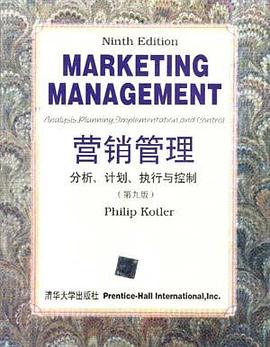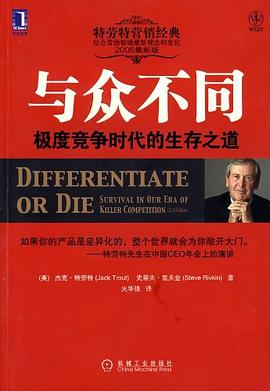BRIEF CONTENTS
UNDERSTANDING MARKETING MANAGEMENT
1 Assessing Marketing's Critical Role in Organizational Performance
2 Building Customer Satisfaction Through Quality, Service, and Value
3 Winning Markets Through Market-Oriented Strategic Planning
ANALYZING MARKETING OPPORTUNITIES
4 Managing Marketing Information and Measuring Market Demand
5 Scanning the Marketing Environment
6 Analyzing Consumer Markets and Buying Behavior
7 Analyzing Business Markets and Business Buying Behavior
8 Analyzing Industries and Competitors
9 Identifying Market Segments and Selecting Target Markets
DEVELOPING MARKETING STRATEGIES
10 Differentiating and Positioning the Market Offering
11 Developing New Products
12 Managing Life-Cycle Strategies
13 Designing Marketing Strategies for Market Leaders, Challengers,Followers, and Nichers
14 Designing and Managing Global Marketing Strategies
PLANNING MARKETING PROGRAMS
15 Managing Product Lines, Brands, and Packaging
16 Managing Service Businesses and Product Support Services
17 Designing Pricing Strategies and Programs
18 Selecting and Managing Marketing Channels
19 Managing Retailing, Wholesaling, and Market Logistics
20 Designing and Managing Integrated Marketing Communications
21 Managing Advertising, Sales Promotion, and Public Relations
22 Managing the Sales Force
23 Managing Direct and Online Marketing
MANAGING THE MARKETING EFFORT
Organizing, Implementing, Evaluating, and Controlling Marketing
Activities
TECHNICAL APPENDIXES
Appendix 1. The Theory of Effective Marketing-Resource Allocation
Appendix 2. Statistical Methods for Future Demand Projection
AUTHOR INDEX
COMPANY/BRAND INDEX
SUBJECT INDEX
Preface
Part l
UNDERSTANDING MARKETING
MANAGEMENT
CHAPTER 1 Assessing Marketing's Critical Role in Organizational
Performance
DOING BUSINESS IN THE GLOBAL ECONOMY
The Global Economy ?The Income Gap ?The
Environmental Imperative and Other Business Trends ? Technological Advances ?Focus on the Customer ? Other Issues
WHAT IS MARKETING? THE CORE CONCEPTS
Needs, Wants, and Demands ?Products (Goods, Services,
and Ideas) ?Value, Cost, and Satisfaction ?Exchange
and Transactions ?Relationships and Networks ? Markets ?Marketers and Prospects
MARKETING MANAGEMENT
COMPANY ORIENTATIONS TOWARD THE
MARKETPLACE
The Production Concept ?The Product Concept ? The Selling Concept/Sales Concept ?The Marketing
Concept ?The Societal Marketing Concept
THE RAPID.ADOPTION OF MARKETING
MANAGEMENT
In the Business Sector ?In the Nonprofit Sector ?In;
the Global Sector
SUMMARY
CONCEPT APPLICATIONS
NOTES
CHAPTER 2 Building Customer Satisfaction Through Qualtty,
Service, and Value
DEFINING CUSTOMER VALUE AND SATISPACTION
Customer Value ?Customer Satisfaction
DELIVERING CUSTOMER VALUE AND
SATISFACTION
Value Chain ?Value-Delivery Network
ATTRACTING AND RBTAINING CUSTOMERS
Computihg the Cost ofLostCustomers ?TheNeedfor
Customer Retention ?Relationship Marketing:
The Key
CUSTOMER PROFITABILITY: THE ULTIMATE TEST
IMPLEMENTING TOTAL QUALITY MARKETING
SUMMARY
CONCEPT APPUCATIONS
NOTES
CHAPTBR 3 Winning Markets Through Market-Oriented Strategic
Planning
THE NATURE OF HlGH-PERFORMANCE BUSINESSES
Stakeholders ?Processes ?Resources ? Organization and Organizational Culture
CORPORATE AND DlVISION STR ATEGIC PLANNING
Defining the Corporate Mission ?Establishing Strategic
Business Units ?Assigning Resources to Each SBU ? Planning New Businesses ?Downsizing Older
Businesses
BUSINESS STRATEGIC PLANNING
Business Mission 80 ?External Environment Analysis
(Opportunity and Threat Analysis) ?Internal Environment
Analysis (Strengths/Weaknesses Analysis) ?Goal
Formulation ?Strategy Pormulation ?Program
Formulation ?Implementation ?Peedback and
Control
THE MARKETING PROCESS
Analyzing Marketing Opportunities ?Developirig
Marketing Strategies ?Planning Marketing Programs
?Managing the Marketing Effort
PRODUCT PLANNING: THE NATURE AND CONTENTS OF A
MARKETING PLAN
Executive Summary and Table of Contents ?Current
Marketing Situation ?Opportunity and Issue Analysis
?Objectives ?Marketing Strategy ?Action
Programs ?Projected Profit-and-Loss Statement ? Controls
THE SHAPE OF MARKETING PLANNING IN THE
1990s
SUMMARY
CONCEPT APPLICATIONS
NOTES
Part 11
ANALYZING MARKETING
OPPORTUNITIES
CHAPTER 4 Managing Marketing Information and Measuring
Market Demand
WHAT IS A MARKETING INFORMATION SYSTEM?
INTERNAL RECORDS SYSTEM
The Order-to-Payment Cycle ?Sales Reporting
Systems
MARKETING INTELLIGENCE SYSTEM
MARKETING RESEARCH SYSTEM
Suppliers ofMarketing Research ?The Marketing Research
Process ?The Characteristics ofGoodMarketing Research
?Overcoming Barriers to the Use ofMarketing Research
MARKETING DECISION SUPPORT SYSTEM
AN OVERVIEW OF FORECASTING AND DEMAND
MEASUREMENT
Measures of Market Demand ?Which Market to
Measure? ?A Vocabulary for Demand Measurement
?Estimating Current Demand ?Estimating Future
Demand
SUMMARY
CONCEPT APPLICATIONS
NOTES
CHAPTER 5 Scanning the Marketing Environment
ANALYZING NEEDS AND TRENDS IN THE
MACROENVIRONMENT
IDENTIFYING AND RESPONDING TO THE MAJOR
MACROENVIRONMENT FORCES
Demographic Environment ?Economic Environment
?Natural Environment
?Political/Legal Environment
Environment
SUMMARY
CONCEPT APPLICATIONS
NOTES
CHAPTER 6 Analyzing Consumer Markets and Buying
Behavior
A MODEL OF CONSUMER BEHAVIOR
MAJOR FACTORS INFLUENCING BUYING
BEHAVIOR
Cultural Factors ?Social Factors ?Personal
Factors ?Psychological Factors
?Technological Environment
?Social/Cultural
THE BUYING PROCESS
Buying Roles ?Buying Behavior
the Buying Decision Process
SUMMARY
CONCEPT APPLICATIONS
NOTES
?The Stages of
CHAPTER 7 Analyzing Business Markets and Business Buying
Behavior
WHAT IS ORGANIZATIONAL BUYING?
The Business Market versus the Consumer Market ? Buying Situations ?Participants in the Business Buying
Process ?Major Influences on Business Buyers ? The Purchasing/Procurement Process
INSTITUTIONAL AND GOVERNMENT MARKETS
SUMMARY
CONCEPT APPLICATIONS
NOTES
CHAPTER 8 Analyzing Industries and Competitors
IDENTIFYING COMPETITORS
Industry Concept of Competition ?Market Concept of
Competition
IDENTIFYING COMPETITORS' STRATEGIES
DETERMINING COMPETITORS' OBJECTIVES
ASSESSING COMPETITORS' STRENGTHS AND
WEAKNESSES
ESTIMATING COMPETITORS' REACTION PATTERNS
DESIGNING THE COMPETITIVE INTELLIGENCE
SYSTEM
SELECTING COMPETITORS TO ATTACK AND AVOID
BALANCING CUSTOMER AND COMPETITOR
ORIENTATIONS
SUMMARY
CONCEPT APPLICATIONS
NOTES
CHAPTER 9 Identifying Market Segments and Selecting Market
Targets
MARKET SEGMENTATION
Levels of Market Segmentation ?Patterns of Market
Segmentation ?Market-Segmentation Procedure ? Bases for Segmenting Consumer Markets ?Bases for
Segmenting Business Markets ?Requirements for Effective
Segmentation
MARKET TARGETING
Evaluating the Market Segments ?Selecting the Market
Segments ?Additional Considerations in Evaluating and
Selecting Segments
SUMMARY
CONCEPT APPLICATIONS
NOTES
Part lll
DEVELOPING MARKETING STRATEGIES
CHAPTER 10 Differentiating and Positioning the Market
Offering
TOOLS FOR COMPETITIVE DlFFERENTIATION
Product Differentiation ?Services Differentiation
Personnel Differentiation ?Channel Differentiation
?Image Differentiation
DEVELOPING A POSITIONING STRATEGY
How Many Differences to Promote? ?Which Differences
to Promote?
COMMUNICATING THE COMPANY'S POSITIONING
SUMMARY
CONCEPT APPLICATIONS
NOTES
CHAPTER 11 Developing New Products
CHALLENGES IN NEW-PRODUCT DEVELOPMENT
EFFECTIVE ORGANIZATIONAL ARRANGEMENTS
MANAGING THE NEW-PRODUCT DEVELOPMENT
PROCESS
Idea Generation ?Idea Screening ?Concept
Development and Tescing ?Marketing Strategy
Development ?Business Analysis ? Product Development ?Market Testing ? Commetcialization
?THE CONSUMER-ADOPTION PROCESS
Stages in the Adoption Process ?Factors Influencing rhe
Adoprion Process
SUMMARY
CONCEPT APPLICATIONS
NOTES
CHAPTER 12 Managing Life-Cycle Strategies
THE PRODUCT LlFE CYCLE
Demand/Technology Life Cycle ?Stages in the Product
Life Cycle ?Product-Category, Product-Form, Product,
and Brand Life Cycles ?Other Shapes of the Product Life
Cycle The International Product Life Cycle
MARKETING STRATEGIES THROUGHOUT THE PLC
Introduction Stage ?Growth Stage ?Maturity
Stage ?Decline Stage
the Product Life-Cycle Concept
MARKET EVOLUTION
Stages in Market Evolution
Competition
SUMMARY
CONCEPT APPLICATIONS
NOTES
?Summary and Cntique of
?Dynamics of Attribute
CHAPTER 13 Designing Marketing Strategies for Market Leaders,
Challengers, Followers, and Nichers
MARKET-LEADER STRATEGIES
Expanding the Total Market ?Defending Market Share
?Expanding Market Share ?Two Case Scudies:
Procter & Gamble and Caterpillar
MARKET-CHALLENGER STRATEGIES
Defining the Strategic Objective and Opponent(s) ? Choosing a General Attack Stracegy ?Choosing a Specific
Attack Strategy
MARKET-FOLLOWER STRATEGIES
MARKET-NlCHER STRATEGIES
Niche Specialization
SUMMARY
CONCEPT APPLICATIONS
NOTES
CHAPTER 14 Designing and Managing Global Marketing
Strategies
DECIDING WHETHER TO GO ABROAD
DECIDING WHICH MARKETS TO ENTER
DECIDING HOW TO ENTER THE MARKET
Indlrect Export ?Direct Export ?Licensing
?Joint Venrures ?Direct Investment ?The
Internationalization Process
DECIDING ON THE MARKETING PROGRAM
Product ?Promotion ?Price ?Place
(Distribution Channels)
DECIDING ON THE MARKETING ORGANIZATION
Export Deparrment ?International Division ? Global Organization
SUMMARY
CONCEPT APPLICATIONS
NOTES
Part IV
PLANNING MARKETING PROGRAMS
CHAPTER 15 Managing Product Lines, Brands, and
Packaging
WHAT IS A PRODUCT?
Five Levels of a Product ?Product Hierarchy ? Product Classifications
PRODUCT-MIX DECISIONS
PRODUCT-LINE DECISIONS
Product-Line Analysis ?Product-Line Length ? Line Modernization ?Line Featuring ?Line
Pruning
BRAND DECISIONS
What Is a Brand? ?The Concept and Measarement of
Brand Equity ?Challenges in Branding
PACKAGING AND LABELING DECISIONS
Packaging ?Labeling
SUMMARY
CONCEPT APPLICATIONS
NOTES
CHAPTER 16 Managing Service Businesses and Product Support
Services
THE NATURE AND CLASS.IFICATION OF SERVICES
CHARACTERISTICS OF SERVICES AND THEIR MARKETING
IMPLICATIONS
Intangibility ?Inseparability ?Variability
Perishability
MARKETING STRATEGIES FOR SERVICE FlRMS
Managing Differentiation ?Managing Service Quality
?Managing Productivity
MANAGING PRODUCT SUPPORT SERVICES
Postsale Service Strategy
SUMMARY
CONCEPT APPLICATIONS
NOTES
CHAPTER 17 Designing Pricing Strategies and Programs
SETTING THE PRICE
Selecting the Pricing Objective ?Decermining Demand
?Estimating Costs ?Analyzing Competitors' Costs,
Prices, and Offers ?Selecting a Pricing Method ? Selecting the Final Price
ADAPTING THE PRICE
Geographical Pricing (Cash, Countertrade, and Barter) ? Price Discounts and Allowances ?Promotional Pricing
512 ?Discriminatory Pricing ?Product-Mix Pricing
INITIATING AND RESPONDING TO PRICE CHANGES
Initiating Price Cucs ?Initiating Price Increases ? Reactions to Price Changes ?Responding to Competitors'
Price Changes
SUMMARY
CONCEPT APPLICATIONS
NOTES
CHAPTER 18 Selecting and Managing Marketing Channels
WHAT ARE MARKETING CHANNELS?
Why Are Marketing Intermediaries Used? ?Channel
Functions and Flows ?Channel Levels ?Channels
in the Service Sector
CHANNEL-DESIGN DECISIONS
Analyzing Cuscomers' Desired Service Output Levels ? Establishing the Channel Objectives and Constraints ? Identifying the Major Channel Akernatives ?Evaluating
the Major Channel Alternatives
CHANNEL-MANAGEMENT DECISIONS
Selecting Channel Members ?Motivating Channel
Members ?Evaluating Channel Members ? Modifying Channel Arrangements
CHANNEL DYNAMICS
Vertical Marketing Systems ?Horizontal Marketing
Systems Multchannel Marketing Systems ? Roles oflndividual Firms in a Channel
CHANNEL COOPERATION, CONFLICT, AND
COMPETITION
Types ofConflict and Competition ?Causes ofChannel
Conflict ?Managing Channel Conflict ?Legal and
Ethical Issues in Channel Relations
SUMMARY
CONCEPT APPLICATIONS
NOTES
CHAPTER 19 Managing Retailing, Wholesaling, and Market
Logistics
RETAILING
Types of Retailers ?Retailer Marketing Decisions ? Trends in Retailing
WHOLESALING
The Growth and Types ofWholesaling ?Wholesaler
Marketing Decisions ?Trends in Wholesaling
MARKET LOGISTICS
Market-Logistics Objectives ?Market-Logistics Detisions
?Organizational Lessons About Market Objeccives
SUMMARY
CONCEPT APPLICATIONS
NOTES
CHAPTER 20 Designing and Managing Integrated Marketing
Communications
A VlEW OF THE COMMUNICATION PROCESS
DEVELOPING EFFECTIVE COMMUNICATIONS
Identifying the Target Audience ?Determining the
Communication Objectives ?Designing the Message
?Selecting the Communicacion Channels ? Establishing the Total Promotion Budget ?Deciding on
the Promotion Mix ?Measuring the Promotion's Results
?Managing and Coordinating Integrated Marketing
Communications
SUMMARY
CONCEPT APPLICATIONS
NOTES
CHAPTER 21 Managing Advertising, Sales Promotion, and Public
Relations
DEVELOPING AND MANAG'ING AN ADVERTISING
PROGRAM
Setting the Advertising Objectives ?Deciding on the
Advertising Budget ?Choosing the Advertising Message
?Deciding on the Media ?Evaluating Advertising
Effecciveness
SALES PROMOTION
The Rapid Growth ofSales Promotion ?Purpose of Sales
Promotion ?Major Decisions in Sales Promotion
PUBLIC RELATIONS
Major Decisions in Marketing PR
SUMMARY
CONCEPT APPLICATIONS
NOTES
CHAPTER 22 Managing the Sales Force
DESIGNING THE SALES FORCE
Sales Force Objectives ?Sales Force Strategy ? Sales Force Structure ?Sales Force Size ?Sales
Force Compensation
MANAGING THE SALES FORCE
Recruiting and Selecting Sales Representatives ?Training
Sales Representacives ?Supervising Sales Representatives
696 ?Motivating Sales Represencatives ?Evaluating Sales
Representative.s
PRINCIPLES OF PERSONAL SELLING
Sales Professionalism ?Negotiation ?Relationship
Marketing
SUMMARY
CONCEPT APPLICATIONS
NOTES
CHAPTER 23 Managing Direct and Online
Marketing
THE GROWTH AND BENEFITS OF DlRECT
MARKETING
The Growth of Direct Marketing and Electronic Shopping ? The Benefits of Direct Marketing
CUSTOMER DATABASES AND DlRECT
MARKETING
MAJOR CHANNELS FOR DlRECT MARKETING
Face-to-Face Selling ?Direct-Mail Marketing ? Catalog Marketing ?Telemarketing ?Television
and Other Major Media Direct-Response Marketing ? Kiosk Marketing ?Online Channels
MARKETING IN THE TWENTY-FIRST CENTURY: ONLINE
MARKETING
The Benefits ofOnline Marketing ?Online Marketing
Channels
THE GROWING USE OF INTEGRATED DlRECT
MARKETING
PUBLIC AND ETHICAL ISSUES IN THE USE OF DlRECT
MARKETING
SUMMARY
CONCEPT APPLICATIONS
NOTES
Part V
MANAGING THE MARKETING EFFORT
CHAPTER 24 Organizing, Implementing, Evaluating, and
Controlling Marketing Activities
COMPANY ORGANIZATION
MARKETING ORGANIZATION
The Evolution of the Marketing Department ?Ways of
Organizing the Marketing Department ?Marketing's
Relations with Other Departments ?Scracegies for
Building a Companywide Marketing Orientation
MARKETING IMPLEMENTATION
CONTROLLING MARKETING ACTIVITY
Annual-Plan Control ?Profitability Control
Efficiency Control ?Strategic Control
SUMMARY
· · · · · · (
收起)






















